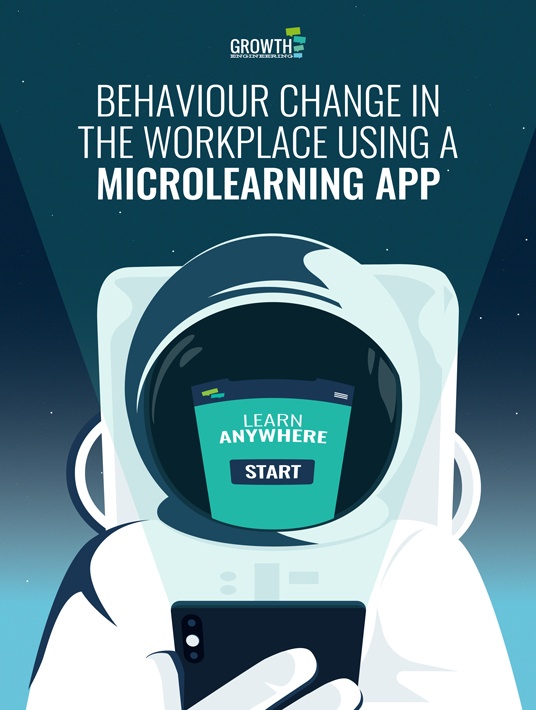What To Ignore As An L&D Manager When It Comes To Myths Of Behaviour Change
Did you know that 80% of New Year’s Resolutions fail [1]? This proves that behaviour change isn’t such an easy process. Even though mobile learning apps have opened up new ways to ensure your training leads to behaviour change, it still requires focus, patience, and practice. As with all important topics, there are plenty of myths surrounding behaviour change. Here are 6 myths that are certifiably false.

1. Behaviour Change Equals Learning
Some think that knowledge on its own is enough to change behaviour, but behaviour change needs plenty of nurturing. It’s important that training is regularly reinforced so that the required information works its way deep into the learner’s brain. But, more than just knowledge is needed.
B. J. Fogg’s model for behaviour change shows that learners need 3 things to initiate a successful change in behaviour:
- The motivation to change a behaviour
- The ability to do so
- A trigger to prompt action
Whenever there’s a failure to change a behaviour either motivation, ability or a prompt is missing from the mix.
2. Behaviours Can Change Overnight
Research suggests that it takes 66 days to form a habit [2]. Anything less, and you’re not likely to adopt or change a behaviour. This is because the brain is always searching for new ways to save on power. One of the ways it does so is by forming habits. When you first learn something a new neural pathway is built. A neural pathway sends information from one part of the brain to another. The more often you use the information you have learned, the more often the pathway is used. This means it will become more and more established over time! Knowing this information gives you the secret to behaviour change (if you can remember it), but it does show us that behaviour change is not an overnight process. There are no shortcuts!
3. Behaviour Change Is An Individual Effort
Behaviour change sounds like an individual effort. This might be because we’re so used to trying to change our habits and behaviours on our own. Whether that’s watching less Netflix or going to the gym more often, we tend to think of behaviour change as a private struggle. Just like a personal trainer can help you find the motivation to go to the gym, behaviour change in the workplace is much more effective when it’s a team effort! “Change initiatives work best when everyone’s sight is fixed on the same goal.” - Zenger & Folkman [3].
4. Behaviour Change Is Unimportant
Businesses often overlook behaviour change, mistaking it for something that is: a) unachievable and b) has no overall effect on the company. Behaviour change most definitely can be achieved, you just need to know-how. As for the effects it can have on a business, frontline employees taking the initiative to drive change elevates the success of business transformations to a whopping 71% [4]. Imagine if 71% of your change initiatives were successful. How would that help your organisation achieve its goals?
5. Behaviour Change Is Harder The Older You Get
The prefrontal cortex is the part of the brain that deals with complex cognitive behaviour. It’s also the part of the brain where memories are stored. When you’re young, this area has a springy and malleable texture. Just like a sponge, this means it’s easier to soak up information. This is what we refer to as plasticity. Come 25, and the prefrontal cortex has toughened up to a more resilient consistency. It’s a common misconception that this means it’s harder to change behaviours. This is not true! Although younger people may be able to change behaviours at a faster rate, people over 25 can still learn and therefore, change behaviours. There are certain things that can help aid learning however, such as exercise, meditation, and brain games. As long as you know how to change behaviour then it isn’t hard at all. It just requires the sustained engagement of your learners.
6. Behaviour Change Is Boring
Behaviour change can evoke memories of painful slogs towards seemingly unachievable goals. Most people find diets boring. They’d have a lot more fun chowing down on a slice of pizza. But, behaviour change most definitely does not have to be boring! In fact, what could be more exciting than taking the next step on the road to becoming the person you wish you were? Behaviour change is the most exciting thing you can do. It’s how everyone is able to transform themselves into an everyday superhero! In fact, new experiences trigger the release of dopamine. Dopamine is a neurotransmitter that the brain releases whenever we experience pleasure. You can see how it motivates us in every area of our lives.
Final Word
The myths surrounding behaviour change are many. This is hardly a surprise, considering how important of a topic it is! With 6 myths out of the way, hopefully, you're much clearer on what behaviour change is and what it is not. If you want to take this knowledge to the next level, why not read our eBook Behaviour Change in the Workplace Using a Mobile Learning App. With it, you'll not only get a clear view of what behaviour change is, but you'll discover strategies for driving behaviour change you can begin applying today!
If you still haven't had enough and you want your training to really impact your business, take part in the webinar: "How To Improve Performance & Unleash Potential: A Guide To Behaviour Change Via Microlearning Apps". Growth Engineering will break down how you can improve the performance of your staff. You’ll also learn all about their proven model for changing behaviour and unleashing the potential of your learners using a microlearning app.
References:
- 80% of New Year's resolutions fail by February — here's how to keep yours
- How are habits formed: Modelling habit formation in the real world
- 7 Things Leaders Do to Help People Change
- 13 Mindblowing Organisational Transformation Stats








